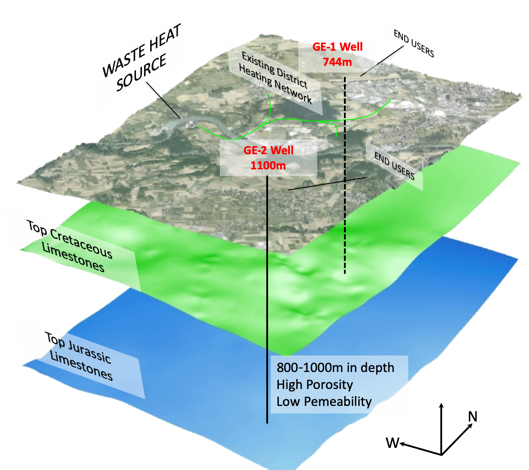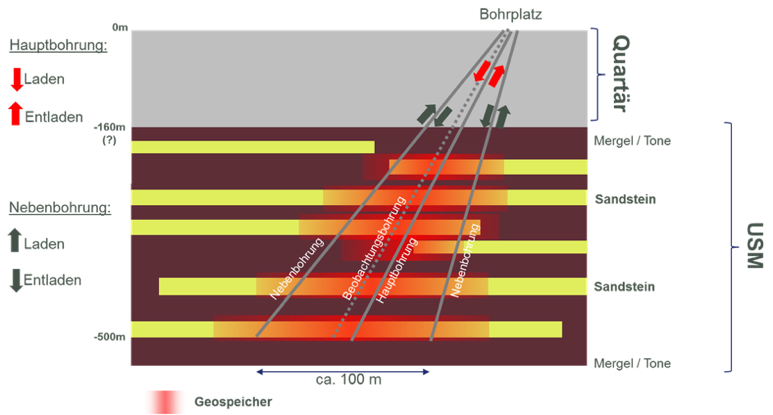The HEATSTORE project: assessing the implementation potential of High Temperature Underground Thermal Heat Storage
HEATSTORE aims at developing High Temperature (~25°C to ~90°C) Underground Thermal Energy Storage (HT-UTES) technologies, which are crucial for the energy system transformation to be successful. Storing heat underground will allow to manage variations in heat supply and demand and store energy for future use. In Switzerland, HEATSTORE focuses on two demonstration projects for High Temperature Aquifer Thermal Energy Storage (HT-ATES). Scientists from the Universities of Geneva, Bern, Neuchâtel and the Swiss Federal Institute of Technology in Zurich (ETHZ) are working on this project in collaboration with industrial operators (Services Industriels de Geneva SIG and Energie Wasser Bern EWB) within the framework of the SCCER-SoE to assess the feasibility of HT-ATES systems in Switzerland.
For the energy transition to succeed, low carbon heat sources need to be established. Heat storage is essential in this development, because it provides the flexibility to manage the variations in supply and demand of heat (for example seasonal changes in heat demand). Additionally, excess heat produced by industrial and civil activities, until now was emitted to the environment, could be stored underground for seasonal supply. It is the main objective of the HEATSTORE project to further develop HT-UTES technologies.
In Switzerland, HEATSTORE aims at conducting two demonstration projects for High Temperature Aquifer Thermal Energy Storage (HT-ATES), where industrial waste heat is converted into a resource. The demonstration projects are located in the cantons of Geneva and Bern.
The HEATSTORE demonstration projects form part of the SCCER-SoE. Scientists from the Universities of Geneva, Bern, Neuchâtel and the Swiss Federal Institute of Technology in Zurich (ETHZ) tackle the question whether HT-ATES will be feasible or not. They closely collaborate with two industrial partners, the Services Industriels de Geneva (SIG) and Energie Wasser Bern (EWB).
HEATSTORE’s setup in Switzerland
The activities planned cover subsurface characterization, energy system analysis, surface implementation design, legal framework improvement and business modelling to ensure the sustainability of the projects. This approach is supported by large industrial investments for subsurface characterization. Two wells, down to 750 and 1400 metres below surface level drilled in the Geneva area are providing data about potential targets in the carbonate Mesozoic units. A smaller scale field lab is implemented in Concise (VD) by University of Neuchâtel allowing the execution of thermo-hydraulic testing in the Mesozoic units. Exploration wells, down to 500 metres below ground, will target the Molasse sediments in the Bern area.
These wells not only allow subsurface exploration and characterization, but they will also provide data which the scientists will use for detailed thermal-hydraulic-mechanical-chemical (THMC) modelling to assess the thermal energy storage potential at the two sites. The scientists will combine the results of such numerical modelling with an energy system analysis to quantify the waste heat availability as well as the heat demand and, hence, optimize the production and injection operations. The outcomes of the coupled assessments will help them to design the integration of the new installations into the district-heating network. Legal framework improvements, based on complete technical evaluation and the best-practice sharing with the other European partners, will be an important tool to enable and accelerate the implementation of the HT-ATES systems. At the same time, business modelling helps to calibrate the economic feasibility of the projects and helps industrial partners to plan future investments.

Illustration of the Geneva project aiming to assess the heat storage potential for the development of an HT-ATES system connected to a waste-to-energy plant operated by Services Industriels de Genève (SIG).
How to assess the feasibility of HT-ATES in more detail
The scientists will combine data collected in the framework of the industrial geothermal exploration and development activities driven by SIG and EWB to produce several predictive integrated models. These models will allow evaluating the technical-economical-legal-social feasibility of HT-ATES projects in Switzerland.
The scientists will combine (a) the energy system configuration in terms of excess heat availability and heat demand, and (b) the subsurface conditions to produce a set of ATES systems scenario models. The results allow the scientists to assess the technical feasibility of HT-ATES systems at the two pilot sites.
The models are calibrated according to the data resulting from field operations carried out by the industrial partners to eventually 1) define the most promising scenarios, 2) evaluate the value of the new information provided, 3) evaluate the economic performances of the identified scenarios and 4) link to boundary regulatory and environmental conditions to assess the overall technical, economic, legal and social feasibility of the projects.
Support and funding
The Swiss consortium developing HEATSTORE in Switzerland involves two industrial partners (Services Industriels de Geneva, SIG, and Energie Wasser Bern, EWB) and four academic partners (Universities of Geneva, Bern, Neuchâtel and ETH Zurich), with support from the Swiss Federal Office of Energy.
HEATSTORE (170153-4401) is one of nine projects under the GEOTHERMICA – ERA NET Cofund aimed at accelerating the uptake of geothermal energy in Europe, The HEATSTORE consortium includes 24 partners from nine countries, composing a mix of scientific research institutes and private companies.


